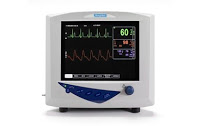
Whenever a pet has to undergo a surgical procedure, owners are often very concerned about how their pet will handle anesthesia and if it is safe. Unfortunately, some patients do not have a surgery that they need because of this fear. Although there are always risks associated with anesthesia, there are things we do to help keep your pet as safe as possible during any operation and to minimize these risks.
At MedVet, all patients are continuously monitored during surgery and anesthesia by both a special monitor and a person who is always with the patient during the entire procedure, recording vital signs and monitoring progress. Our surgical monitor records the patient’s heart rate, respiratory rate, continuous ECG, end tidal carbon dioxide level, blood pressure, and SpO2. The heart rate tells us how fast your pet’s heart is beating. The ECG tells us about the electrical activity of the heart. A normal ECG is pictured below.

Certain diseases can cause heart arrhythmias to occur and an ECG will alert the Doctor to any problems. An ECG of a dog that developed an arrhythmia is pictured below.

The respiratory rate tells us how fast your pet is breathing. The end tidal carbon dioxide level tells us how well they are ventilating their lungs. If a pet is breathing too rapidly and shallow during anesthesia, the end tidal carbon dioxide level will be low. If they are not breathing deeply enough, their end tidal carbon dioxide level will be high. The end tidal carbon dioxide is reported as both a number as well as a graph that gives us additional information about their breathing. A graph of a normal patient is pictured below.

Your pet’s blood pressure is as important as your blood pressure. Often, during anesthesia, the blood pressure will be low. It is important to know this as low blood pressure can have negative effects on the kidneys and brain. Low blood pressure can be treated with fluids and medications during surgery if needed.
The SpO2 level refers to the percentage of oxygenated hemoglobin present in the patient’s blood. Hemoglobin is part of the red blood cell that carries oxygen from the lungs to the tissues. A low value alerts us to the possibility that the patient may not be breathing enough or that there may be something wrong with the lungs causing the pet to be not getting enough oxygen.

